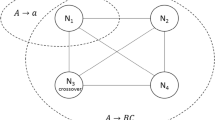Abstract
We consider the networks of evolutionary processors (NEP) introduced by J. Castellanos, C. Martí n-Vide, V. Mitrana and J. Sempere recently. We show that every recursively enumerable (RE) language can be generated by an NEP with three nodes modulo a terminal alphabet and moreover, NEPs with four nodes can generate any RE language. Thus, we improve existing universality result from five nodes down to four nodes. For mNEPs (a variant of NEPs where operations of different kinds are allowed in the same node) we obtain optimal results: each RE language can be generated by an mNEP with one node modulo a terminal alphabet, and mNEPs with two nodes can generate any RE language; this is not possible for mNEPs with one node. Some open problems are formulated.
Similar content being viewed by others
References
Castellanos J., Leupold P., Mitrana V. (2005). On the size complexity of hybrid networks of evolutionary processors. Theor. Comput. Sci. 330(2):205–220
Castellanos, J., Martí n-Vide, C., Mitrana, V., Sempere, J.: Solving NP-complete problems with networks of evolutionary processors. In: Proceedings of IWANN 2001. Lecture Notes in Computer Science 2084, pp. 621–628. Springer, Berlin Heidelberg New York (2001)
Castellanos J., Martí n-Vide C., Mitrana V., Sempere J. (2003). Networks of evolutionary processors. Acta Inform. 39:517–529
Csuhaj-Varjú, E., Dassow, J., Kelemen, J., Păun, G.: Grammar systems. Gordon and Breach (1993)
Csuhaj-Varjú E., Salomaa A.(1997). Networks of parallel language processors. In: Paun Gh., Salomaa A. (eds) New Trends in Formal Languages, Lecture Notes in Computer Science 1218. Springer, Berlin Heidelberg New York, pp. 299–318
Csuhaj-Varjú E., Martí n-Vide C., Mitrana V. (2005). Hybrid networks of evolutionary processors are computationaly complete. Acta Inform. 41(4–5):257–272
Errico, L., Jesshope, C.: Towards a new architecture for symbolic processing. In: Artificial Intelligence and Information-Control Systems of Robots ’94, pp. 31–40. Plander, I. World Scientific, Singapore (1994)
Fahlman, S.E., Hinton, G.E., Seijnowski, T.J.: Massively parallel architectures for AI: NETL, THISTLE and Boltzmann machines. In: Proceedings AAAI National Conf on AI, pp. 109–113 William Kaufman, Los Altos, (1983)
Hillis W.D. (1985). The Connection Machine. MIT Press, Cambridge
Margenstern, M., Mitrana, V., Pérez-Jiménez, M.: Accepting hybrid networks of evolutionary processors. In: Ferretti, C. Mauri, G. Zandron C. (eds.) Pre-proc. of 10th International Workshop on DNA Computing, DNA 10, Milan, Italy, June 7–10, 107–117 2004, Revised Selected Papers, Lecture Notes in Computer Science 3384, pp. 235–246 Springer, Berlin Heidelberg New York (2005)
Margenstern M., Păun G., Rogozhin Yu., Verlan S. (2005). Context-free insertion-deletion systems. Theor. Comput. Sci. 330(2):339–348
Martí n-Vide, C., Mitrana, V., Pérez-Jiménez, M., Sancho-Caparrini. F.: Hybrid networks of evolutionary processors. In: Proceedings of Genetic and Evolutionary Computation Conference (GECCO 2003), Lecture Notes in Computer Science 2723, pp. 401–412. Springer, Berlin Heidelberg New York (2003).
Rozenberg G., Salomaa A. (eds) (1997). Handbook of Formal Languages, vol 1–3. Springer, Berlin Heidelberg New York
Sankoff D., Leduc G., Antoine N., Paquin B., Lang B.F., Cedergren R. (1992). Gene order comparisons for phylogenetic inference: evolution of the mitochondrial genome. Proc. Natl. Acad. Sci. USA 89:6575–6579
Author information
Authors and Affiliations
Corresponding author
Rights and permissions
About this article
Cite this article
Alhazov, A., Martín-Vide, C. & Rogozhin, Y. On the number of nodes in universal networks of evolutionary processors. Acta Informatica 43, 331–339 (2006). https://doi.org/10.1007/s00236-006-0024-x
Received:
Accepted:
Published:
Issue Date:
DOI: https://doi.org/10.1007/s00236-006-0024-x




